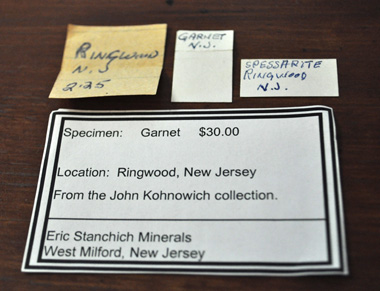 Most mineral specimens come with labels identifying them and their locality. They often have the original dealer or collector’s name on them as well. It is very important to keep all labels that come with a mineral, as one day they will likely be a historical addendum to the mineral itself. Occasionally you may encounter a classic mineral with several labels from different dealers and collectors that it had passed through. All of these labels add to the intrigue, authenticity, and value of the mineral. Even the price label on a mineral should be retained, so that the purchased value will have historical significance one day. It is always amusing seeing the low cost of an old mineral when it was originally for sale as compared to today.
Most mineral specimens come with labels identifying them and their locality. They often have the original dealer or collector’s name on them as well. It is very important to keep all labels that come with a mineral, as one day they will likely be a historical addendum to the mineral itself. Occasionally you may encounter a classic mineral with several labels from different dealers and collectors that it had passed through. All of these labels add to the intrigue, authenticity, and value of the mineral. Even the price label on a mineral should be retained, so that the purchased value will have historical significance one day. It is always amusing seeing the low cost of an old mineral when it was originally for sale as compared to today.
If a mineral lacks locality information, this will have a very serious negative impact on its value. When you purchase mineral specimens that are not labeled, make sure to ask the dealer to write you a label with the mineral name, locality, and the dealer name on it. This should always be kept in proximity to the mineral as a necessary accessory. The more information you can place on a label, the better. For example, useful fields include year collected, date purchased, collected by, original collection of, and so on. Often this information is not available, but if it is, it should definitely be documented. It is also good practice to write your own labels in addition to any existing labels you may have, so that future collectors will historically attribute the mineral to you. Many classic mineral specimens retain a higher value price when accompanied by an old label, especially when they are from a well-known collection.